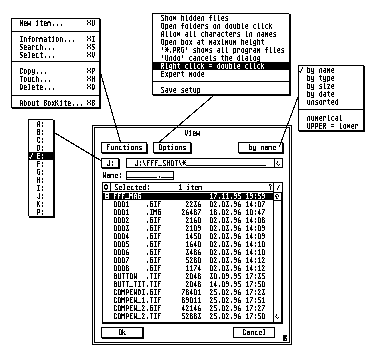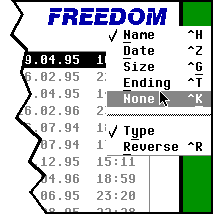
|
|
|

Selectric also introduced the concept of passing many files to one application. Obviously the application in question has to support this function.
Many of the features in Selectric match those found in UIS so why is it more popular? It could come down to looks, Selectric looks the part, but there is more to it than that. All functions are hidden behind popups keeping everything neat and tidy.

As you enter folders Selectric maps the route. Left mouse click on the 'Mac' path pop up or press F2 and each folder above the current one is listed. This way you can jump back more than one directory at a time or all the way back to the root. If you enter a folder and then exit the slider stays put, it doesn't shoot to the top again. Anyone who has used other selectors for any length of time will know how annoying this can be.
The find function, accessed though the Function popup supports full wildcard searches. Vital if you can't remember the name of the file you're looking for. You'll also be able to create new files or folders from in here as well as get basic drive information. Handy if you not sure whether that new file will fit in the space available.
In the sort popup are the four standard sort modes found at the desktop. In addition to this is an unsorted option, great for checking the Auto folder program run order. There are also reverse sort and numeric sort functions. The numeric sort option comes into play when you name files using numbers. You may create files called mytext_5.doc, mytext_2.doc, mytext11.doc and mytext_4.doc. With the numeric switch on these would be shown as mytext_2.doc, mytext_4.doc, mytext_5.doc and mytext11.doc.
 Supplied with this selector is an accessory and a CPX. Both can be
used to call the selector. Additionally the CPX can be used to switch
Selectric off, just in case you need to return to the TOS selector.
This may be necessary if it clashes with a piece of your software.
Having said that I've been using Selectric with no problems for some
time.
Supplied with this selector is an accessory and a CPX. Both can be
used to call the selector. Additionally the CPX can be used to switch
Selectric off, just in case you need to return to the TOS selector.
This may be necessary if it clashes with a piece of your software.
Having said that I've been using Selectric with no problems for some
time.
Selectric is still one of the best. If I was going to be really picky I'd complain about its lack of a floppy disk format function. Also you need to have Let'em Fly installed to make it manoeuvrable. Apart from this it's just about perfect for the single tasking Atari user. Selectric along with the vast majority of selector replacements is very easy to install. All you need to do is copy the Selectric program to your Auto folder. It will then appear instead of the TOS version whenever a program requests it.


Another good feature of Boxkite is the single right click equals double left click feature. A great idea being adopted by more and more programs, the Thing and Ease desktops among them.
Boxkite also supports symbolic links. Another Mint, and now MagiC 4 feature. A symbolic link is very similar to dragging icons onto the desktop. You only need store one copy of the file one your drive but can access it from different locations and under different names. A sort of space saving device.
Boxkite doesn't really make the grade when compared directly with Selectric. It only steps ahead for the few Atari users using Mint or Multi-TOS. It may have a use under the new MagiC 4, but for reasons we'll discuss in a minute I doubt it.

The big clue is in the name, ever noticed how your computer stops working when you open the file selector in a multi-tasking environment, annoying isn't it. Well this selector doesn't do that, true Freedom indeed. Your computer will happily go on working while the Freedom file selector is open. In fact you can have up to eight Freedom's open at the same time.
Selectric introduced some new standards for file selectors and for this reason Freedom can do everything Selectric can do and is 99% Selectric keyboard compatible. It also supports long file names, can have a program installed as a viewer or use your replacement desktop installed application viewer, (providing your desktop supports the AV protocol). Freedom is fully configurable allowing user definable font and size, user definable icons next to file and folder names, import/export paths to/from the clipboard plus file delete, copy & move using Kobold. There's even a built in file search which also refuses to lock up your system while it's working or, if you prefer you can use an external search program such as Paraffin.
The list goes on and on.
One of it's neatest tricks is in the use of both mouse buttons. Left clicking on a button brings up one function and right clicking on the same button brings up a slightly different but related function. For example if you right click on the word FILE, a list of user pre-defined files is displayed to you. If you left click on the word FILE a history list is displayed showing you all the files you've previously loaded. The selection of masks is equally useful, right click on the file extender and you can choose from a list of pre-defined masks, left click and it shows you the file extenders available in the current directory. So if you go into your clipart folder and in there are *.IMG, *.TIF and *.GIF files, left clicking will let you choose instantly between these three file extenders adding *.* at the beginning of the pop-up in case you need it. Double clicking enters the mask edit dialog for those of you wishing to enter your own masks.
There are many hidden but handy features inside Freedom. Mouse clicking on the characters that make up the path allows you to quickly navigate around your hard drive. If you right click on the path a list of pre-defined paths is displayed. Left clicking gives you several choices depending on which area of the path you've selected. If you select part of the path that includes a folder name Freedom displays a list of folders in that directory. Select the backslash character and Freedom will jump to that path instantly. Obviously selecting the drive letter gives you a choice of drives matching those connected to your system.
 Other areas where mouse clicks produce a response include
the window scroller and the five icons found at the bottom of the
selector. Clicking on the scroller button gives you the sort dialog.
The five icons include trash can, search, info, clipboard and create
file/folder. All have the dual use of left/right click or if you
prefer single left click, double left click. It goes without saying
that the selector can be moved, re-sized, iconised, cloned, operated
on in the background and supports multiple file selection for those
pieces of software that can handle it.
Other areas where mouse clicks produce a response include
the window scroller and the five icons found at the bottom of the
selector. Clicking on the scroller button gives you the sort dialog.
The five icons include trash can, search, info, clipboard and create
file/folder. All have the dual use of left/right click or if you
prefer single left click, double left click. It goes without saying
that the selector can be moved, re-sized, iconised, cloned, operated
on in the background and supports multiple file selection for those
pieces of software that can handle it.
Obviously this selector is designed for multi-tasking but it still works in a single tasking configuration. I would recommend the use of Gemini, Ease or Thing though, to get the best out of it.
There is one dark cloud in an otherwise clear sky though, you cannot currently save the selectors configuration, if you want to personalise this selector you will need your trusty text editor to manually edit the config file. However the file is very clearly commented and I found it straight forward to edit. The author assures users that a configuration program is in development, so it's not that bad.
As you can probably tell I love this file selector, it's very well designed and apart from the config file, easy to use. It's probably a little memory hungry but for features like the above and another page full I haven't even mentioned, 120kb is memory well spent.
|
|
|